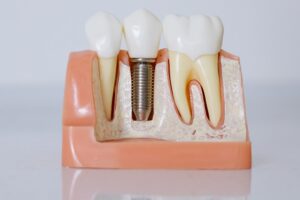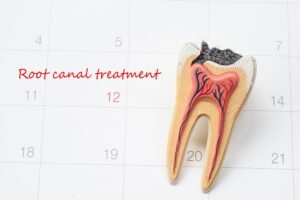Our smiles are often the first thing people notice. When a chipped tooth or a nagging cavity throws a wrench in your pearly whites, it can be a major confidence blow. But fear not, friends, for the dental crown, the unsung hero of oral health, is here to the rescue!
What is a Dental Crown?
Imagine a tiny, custom-made hat for your tooth. That’s what a dental crown is. It’s a tooth-shaped cap that completely encases the visible portion of a tooth, restoring its form, function, and aesthetics. Think of it as a superhero suit for your chompers, granting them enhanced strength, resilience, and (sometimes) dazzling good looks.
Why Get a Crown?
Dental crowns serve a lot of purposes:
Reinforcing a Fragile Tooth: If a tooth is cracked, chipped, or weakened by decay, a crown can swaddle it in protective armor, preventing further damage and restoring its chewing prowess.
Saving a Tooth After Root Canal Therapy: After a root canal, a tooth becomes brittle. A crown acts like a knight’s shield, safeguarding it from fractures and keeping your smile intact.
Restoring Lost Beauty: Discolored, misshapen, or severely worn teeth can get a confidence boost with a den crown that blends seamlessly with your natural teeth, giving you a reason to flash those pearly whites again.
Supporting Dental Bridges and Implants: Crowns can serve as anchors for dental bridges, filling in gaps left by missing teeth. They can also act as the topper for dental implants, providing a natural-looking tooth where once there was none.
What are the different types of crowns?
Not all crowns are created equal! Each material offers unique pros and cons, making it important to choose the one that best suits your needs and budget.
Metal Dental Crowns: The OG of crowns, metal (usually gold or alloys), is renowned for its unmatched durability. However, their metallic glint might not be everyone’s cup of tea for front teeth. Stainless steel crowns are usually given to children post Root Canal Treatment.
Porcelain-Fused-to-Metal (PFM) Crowns: These combine the strength of metal with the aesthetics of porcelain, making a natural-looking and sturdy option. However, the metal substructure can sometimes show through, especially as gums recede.
All-Ceramic (Porcelain) Crowns: For those who prioritize aesthetics, all-ceramic crowns are the undisputed champions. They mimic the natural translucence of teeth, virtually disappearing into your smile. They are also compatible with gum tissues and prevent dark gum margins.
Resin Crowns: These are the budget-friendly option, often used for temporary crowns or on back teeth where aesthetics are less of a concern. While less durable than other materials, they can be a good quick solution.
The Procedure of Dental Crown Placement: Dental Crowning
Getting a crown usually involves two visits to your friendly neighborhood dentist. Here’s what the process of Dental Crown Placement looks like.
Prep Time: During the first visit, your dentist will numb the area, remove any decay, and reshape the tooth to create a snug fit for the crown.
Impression Party: An impression of the prepared tooth is taken to create a mold for your custom-made crown.
Try-On Time: At your second visit, the dentist always check the fit as well as the color of your crown, making adjustments if needed. Once everything is perfect, they’ll permanently cement it in place.
With proper care, your crown can be your smile’s loyal companion for many years to come. Here are some tips to keep your crowned tooth happy:
Brush and floss regularly: Treat your crowned tooth just like your natural teeth. Good oral hygiene is key to preventing problems like gum disease.
Avoid hard objects: Don’t chew on ice cubes, pens, or other hard objects that could chip or crack your crown.
Schedule regular dental checkups: Your dentist can monitor your crown’s health and address any potential issues early on.







